Jaewoo Jeong
Non-differentiable Reward Optimization for Diffusion-based Autonomous Motion Planning
Jul 17, 2025
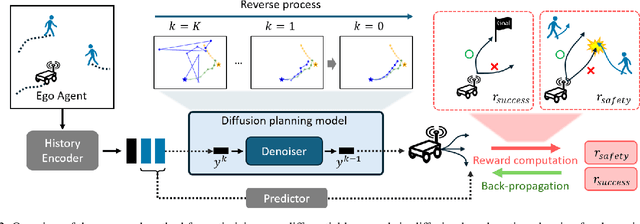
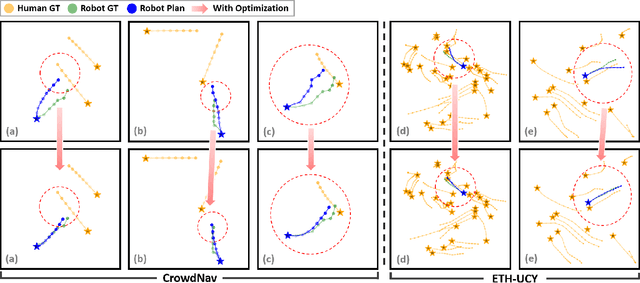

Abstract:Safe and effective motion planning is crucial for autonomous robots. Diffusion models excel at capturing complex agent interactions, a fundamental aspect of decision-making in dynamic environments. Recent studies have successfully applied diffusion models to motion planning, demonstrating their competence in handling complex scenarios and accurately predicting multi-modal future trajectories. Despite their effectiveness, diffusion models have limitations in training objectives, as they approximate data distributions rather than explicitly capturing the underlying decision-making dynamics. However, the crux of motion planning lies in non-differentiable downstream objectives, such as safety (collision avoidance) and effectiveness (goal-reaching), which conventional learning algorithms cannot directly optimize. In this paper, we propose a reinforcement learning-based training scheme for diffusion motion planning models, enabling them to effectively learn non-differentiable objectives that explicitly measure safety and effectiveness. Specifically, we introduce a reward-weighted dynamic thresholding algorithm to shape a dense reward signal, facilitating more effective training and outperforming models trained with differentiable objectives. State-of-the-art performance on pedestrian datasets (CrowdNav, ETH-UCY) compared to various baselines demonstrates the versatility of our approach for safe and effective motion planning.
Multi-modal Knowledge Distillation-based Human Trajectory Forecasting
Mar 28, 2025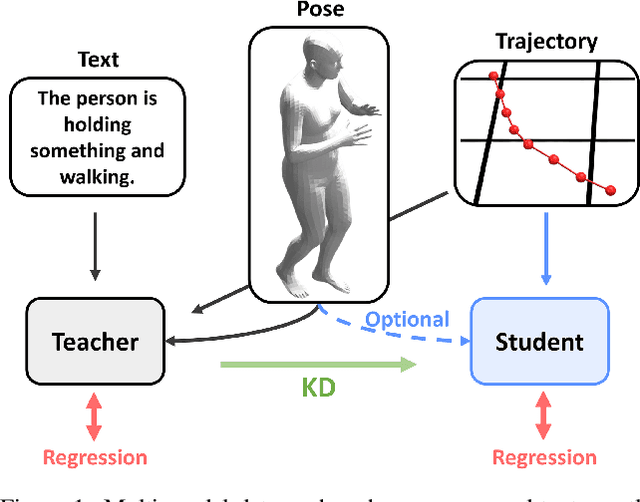

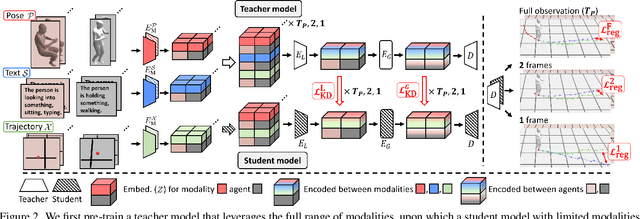

Abstract:Pedestrian trajectory forecasting is crucial in various applications such as autonomous driving and mobile robot navigation. In such applications, camera-based perception enables the extraction of additional modalities (human pose, text) to enhance prediction accuracy. Indeed, we find that textual descriptions play a crucial role in integrating additional modalities into a unified understanding. However, online extraction of text requires the use of VLM, which may not be feasible for resource-constrained systems. To address this challenge, we propose a multi-modal knowledge distillation framework: a student model with limited modality is distilled from a teacher model trained with full range of modalities. The comprehensive knowledge of a teacher model trained with trajectory, human pose, and text is distilled into a student model using only trajectory or human pose as a sole supplement. In doing so, we separately distill the core locomotion insights from intra-agent multi-modality and inter-agent interaction. Our generalizable framework is validated with two state-of-the-art models across three datasets on both ego-view (JRDB, SIT) and BEV-view (ETH/UCY) setups, utilizing both annotated and VLM-generated text captions. Distilled student models show consistent improvement in all prediction metrics for both full and instantaneous observations, improving up to ~13%. The code is available at https://github.com/Jaewoo97/KDTF.
Multi-agent Long-term 3D Human Pose Forecasting via Interaction-aware Trajectory Conditioning
Apr 08, 2024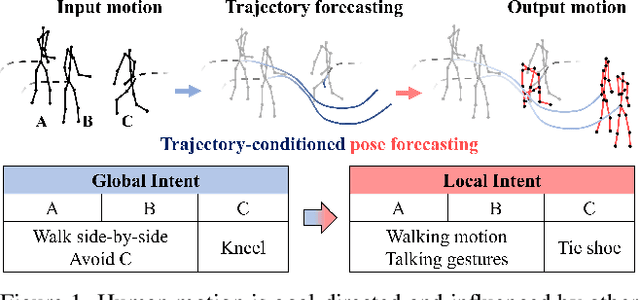
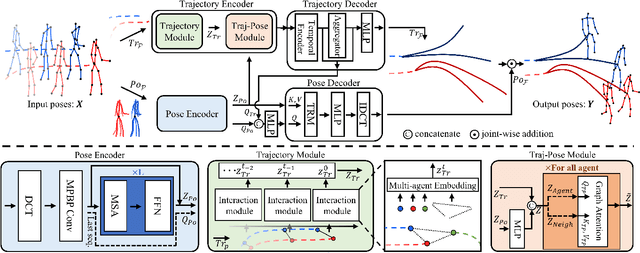
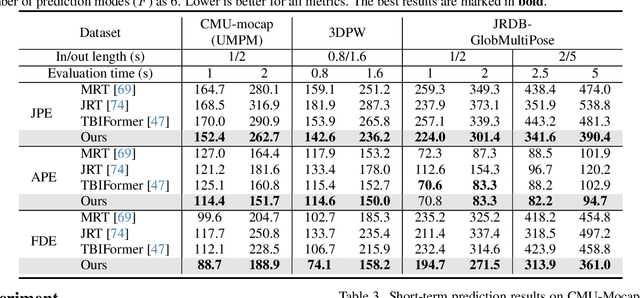
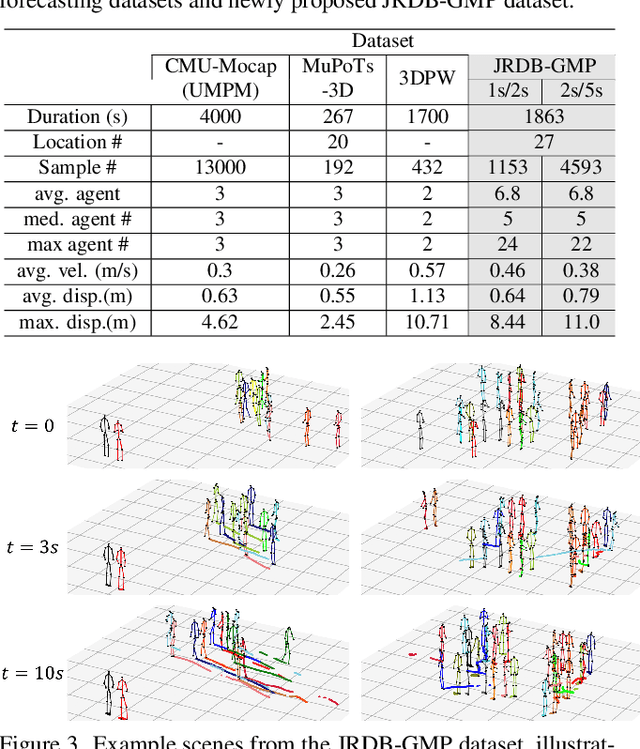
Abstract:Human pose forecasting garners attention for its diverse applications. However, challenges in modeling the multi-modal nature of human motion and intricate interactions among agents persist, particularly with longer timescales and more agents. In this paper, we propose an interaction-aware trajectory-conditioned long-term multi-agent human pose forecasting model, utilizing a coarse-to-fine prediction approach: multi-modal global trajectories are initially forecasted, followed by respective local pose forecasts conditioned on each mode. In doing so, our Trajectory2Pose model introduces a graph-based agent-wise interaction module for a reciprocal forecast of local motion-conditioned global trajectory and trajectory-conditioned local pose. Our model effectively handles the multi-modality of human motion and the complexity of long-term multi-agent interactions, improving performance in complex environments. Furthermore, we address the lack of long-term (6s+) multi-agent (5+) datasets by constructing a new dataset from real-world images and 2D annotations, enabling a comprehensive evaluation of our proposed model. State-of-the-art prediction performance on both complex and simpler datasets confirms the generalized effectiveness of our method. The code is available at https://github.com/Jaewoo97/T2P.
T4P: Test-Time Training of Trajectory Prediction via Masked Autoencoder and Actor-specific Token Memory
Mar 15, 2024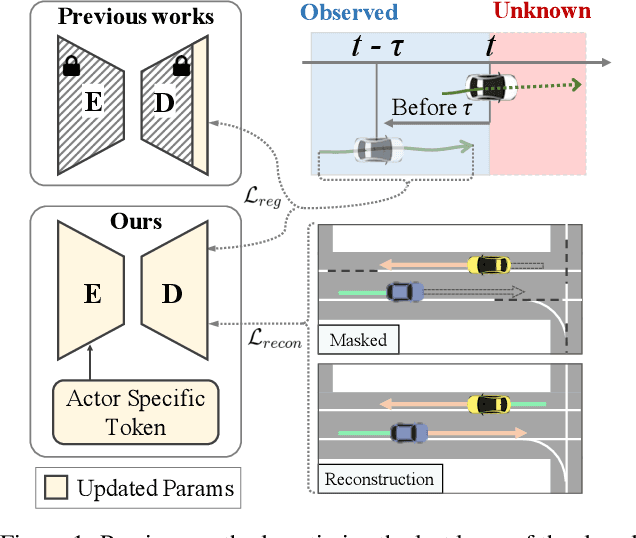
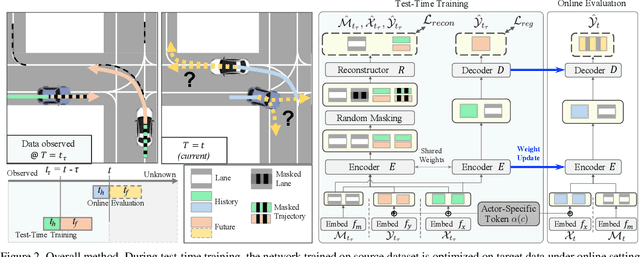
Abstract:Trajectory prediction is a challenging problem that requires considering interactions among multiple actors and the surrounding environment. While data-driven approaches have been used to address this complex problem, they suffer from unreliable predictions under distribution shifts during test time. Accordingly, several online learning methods have been proposed using regression loss from the ground truth of observed data leveraging the auto-labeling nature of trajectory prediction task. We mainly tackle the following two issues. First, previous works underfit and overfit as they only optimize the last layer of the motion decoder. To this end, we employ the masked autoencoder (MAE) for representation learning to encourage complex interaction modeling in shifted test distribution for updating deeper layers. Second, utilizing the sequential nature of driving data, we propose an actor-specific token memory that enables the test-time learning of actor-wise motion characteristics. Our proposed method has been validated across various challenging cross-dataset distribution shift scenarios including nuScenes, Lyft, Waymo, and Interaction. Our method surpasses the performance of existing state-of-the-art online learning methods in terms of both prediction accuracy and computational efficiency. The code is available at https://github.com/daeheepark/T4P.
Improving Transferability for Cross-domain Trajectory Prediction via Neural Stochastic Differential Equation
Dec 26, 2023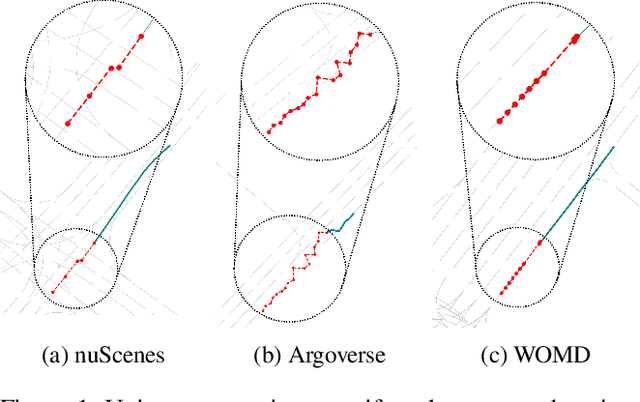

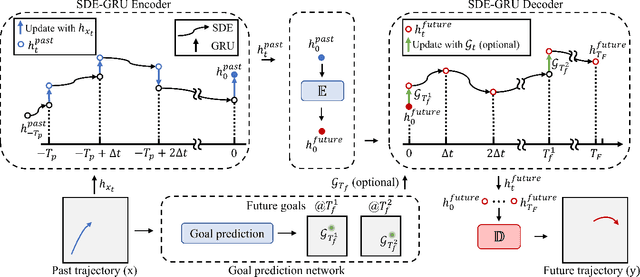
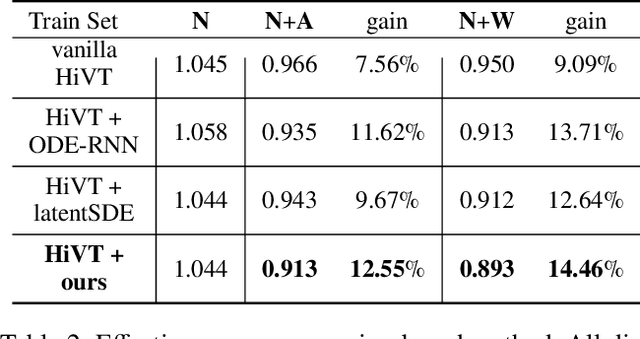
Abstract:Multi-agent trajectory prediction is crucial for various practical applications, spurring the construction of many large-scale trajectory datasets, including vehicles and pedestrians. However, discrepancies exist among datasets due to external factors and data acquisition strategies. External factors include geographical differences and driving styles, while data acquisition strategies include data acquisition rate, history/prediction length, and detector/tracker error. Consequently, the proficient performance of models trained on large-scale datasets has limited transferability on other small-size datasets, bounding the utilization of existing large-scale datasets. To address this limitation, we propose a method based on continuous and stochastic representations of Neural Stochastic Differential Equations (NSDE) for alleviating discrepancies due to data acquisition strategy. We utilize the benefits of continuous representation for handling arbitrary time steps and the use of stochastic representation for handling detector/tracker errors. Additionally, we propose a dataset-specific diffusion network and its training framework to handle dataset-specific detection/tracking errors. The effectiveness of our method is validated against state-of-the-art trajectory prediction models on the popular benchmark datasets: nuScenes, Argoverse, Lyft, INTERACTION, and Waymo Open Motion Dataset (WOMD). Improvement in performance gain on various source and target dataset configurations shows the generalized competence of our approach in addressing cross-dataset discrepancies.
 Add to Chrome
Add to Chrome Add to Firefox
Add to Firefox Add to Edge
Add to Edge